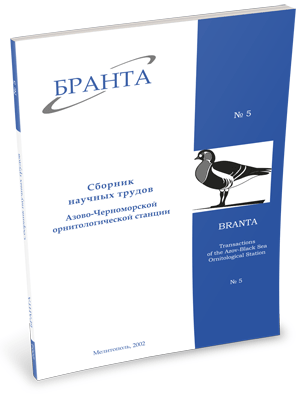
Transactions
of the Azov-Black Sea Ornithological Station



Distribution and number of waterfowls during the period after breeding in Stensovsko-Zhebriansky plavni of the Danube delta in 2002.
Koshelev A.I., Popenko V.M., Koshelev V.A., Chichkin V.N.
There are given the results of counts of waterfowls along pedestrian and boat routes, taken during August 2002 in Stensovsko-Zhebriyansky plavni (SZP) of the Danube delta (Odessa region). 66,200 individuals of 80 species were registered including 28,248 individuals of waterfowls. Their distribution per different types of habitats, density and areas of summer-autumn gatherings (moulting birds and fledglings) were determined. Coot and Mute Swan had maximal density (up to 6,000 ind/100ha and 520ind/100 ha correspondingly). Areas of Grabovsky liman with bushy type of reed growth and vast open water areas were the most valuable sites for birds. During August in Stensovsko-Zhebriyansky plavni birds arrived for feeding and vagrants dominated (59.2%); local breeding species amounted to 30.3%, birds arrived for moulting – 10.5%. Before the hunting season in 2000 the estimated number of fair game of waterfowls reached 41,000 individuals. It was 3-5 times lower than during the previous wet years. In the end of summer the waterfowls used only 15-20% of Stensovsko-Zhebriyansky plavni, completely avoiding dried up shallows and vast territories of dense reed beds.
Read the paper in a PDF file